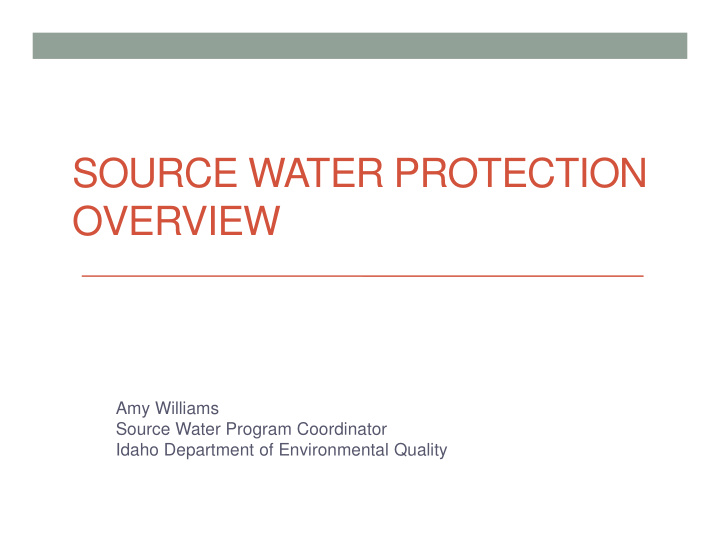



SOURCE WATER PROTECTION OVERVIEW Amy Williams Source Water Program Coordinator Idaho Department of Environmental Quality
Who is DEQ? • The Department of Environmental Quality’s mission is to protect human health and the quality of Idaho’s air, land, and water • State Office • 6 Regional Offices
DEQ Programs to Protect Drinking Water Source Water Program: Protect drinking water at the source • Coordinate state protection efforts • Conduct Source Water Assessments Drinking Water Program : Protect drinking water at the tap
Source Water Defined as “any aquifer, surface water body, or watercourse from which water is taken either periodically or continuously by a public water system for drinking or food processing purposes” Idaho Source Water Assessment Plan
What if it becomes contaminated? • https://www.youtube.com/watch?v=b8dRDV268nA
Safe Drinking Water Multiple Barrier Approach
What IS Source Water Protection? Voluntary or regulatory activities that reduces the risk of contaminants from entering a public water system supply. Types of Protection Activities: • Regulations and Permits • Land conservation • Education, Outreach and Public Programs • Best Management Practices • Planning
Costs and Benefits of Protection Cost of Contamination: Benefits of Protection: • Treatment, clean-up and • Reduced health risks remediation • Reduced treatment • Source replacement costs • Additional regulations and • Healthy ecosystems and monitoring requirements recreational benefits • Loss of property values • Public and consumer confidence • Health related costs • Economic benefits, • Loss of public trust increased property value
How do we know what to protect? Source Water Assessments: • Delineation : Maps area contributing water to the drinking water source • Potential Contaminant Inventory: Identifies potential threats to the source • Susceptibility Analysis: Ranks the susceptibility of the source to contamination
Surface Water Delineation Methods • Watershed Boundary 25 mile + 500-foot buffer • Stream Buffer 25 mile + 500-foot buffer
Potential Contaminant Identification Potential Contaminant Identification � Identify past practices and discharges � Look for the major sources of potential contaminants � Primary and Enhanced Inventories
Nutrients • Most widespread contaminant (Nitrogen and Phosphorus) • Overgrowth can lead to harmful algal blooms (Cyanobacteria) • Can produce toxic chemicals that are harmful to public health.
Source Water Protection to Reduce Nutrient Pollution • Ag BMPs • Storm Water BMPs • Forest Management Practices • Septic maintenance Examples…..
Phosphate Ban in Detergents & Fertilizers Spokane law regulated phosphate in dish detergents (2008) • Resulted in reduction of 10.7% in waste water • Expanded statewide in 2010 along with 15 other states Washington law prohibited sale of turf fertilizer containing phosphorous (2013)
Streambank Stabilization and Revegetation on Elk River, Idaho 1. Reestablish natural riparian area 2. Stabilize eroding creek banks 3. Educate the community on SWP Resulted in an estimated load reduction of 1,207 tpy of sediment, 0.59 tpy of phosphorus and 1.11 tpy of nitrogen.
City of Boise Phosphorus Reduction Dixie Drain Project • 98% reduction in phosphorus required • First of its kind in the US • Removes 10 tons of phosphorus - 50% more than would have been removed at the treatment facility https://vimeo.com/205465513
Land Acquisition • Seattle Washington: Own 100% of Cedar River Watershed • Sandpoint Idaho: Own 53% of Little Sand Creek Watershed
Tools to Protect Source Water Assessment Tools: • SWA Online
Tools to Protect Source Water Assessment Tools: • SWA Online • Sentinel Hub Satellite Imagery https://apps.sentinel-hub.com/sentinel-playground
Satellite Imagery for monitoring… Idaho Department of Environmental Quality
Tools to Protect Source Water Planning Tools: • Source Water Protection Ordinance Template • Source Water Protection Planning and Contingency Planning Application
Tools to Protect Source Water Funding Resources: DEQ Programs • 319 Non Point Source Grant • Brownfields Assessment Program • SRF Grants and Loans • Source Water Protection • Septic program • Nonpoint source projects funding • Source Water Protection Grants (coming soon)
Local Funding Sources Taxes, Fees, and Special Districts Examples: • Central Arkansas Water, Arkansas: $5.40-$8.16 monthly Watershed Protection Fee. • Raleigh, North Carolina: $5.40 annual Watershed Protection Fee. • Bellingham, Washington: $5 (metered) and $12 (non metered) monthly Watershed Rate. • Aquifer Protection District, Kootenai County, Idaho
Summery 1. Source Water Protection is a critical component to ensuring safe drinking water 2. Use maps and resources to identify threats 3. Create a comprehensive source protection plan 4. Build strong partnerships and leverage resources to implement protection measures 5. Prepare for emergencies
QUESTIONS Amy Williams Amy.Williams@deq.idaho.gov 208-373-0115
Recommend
More recommend